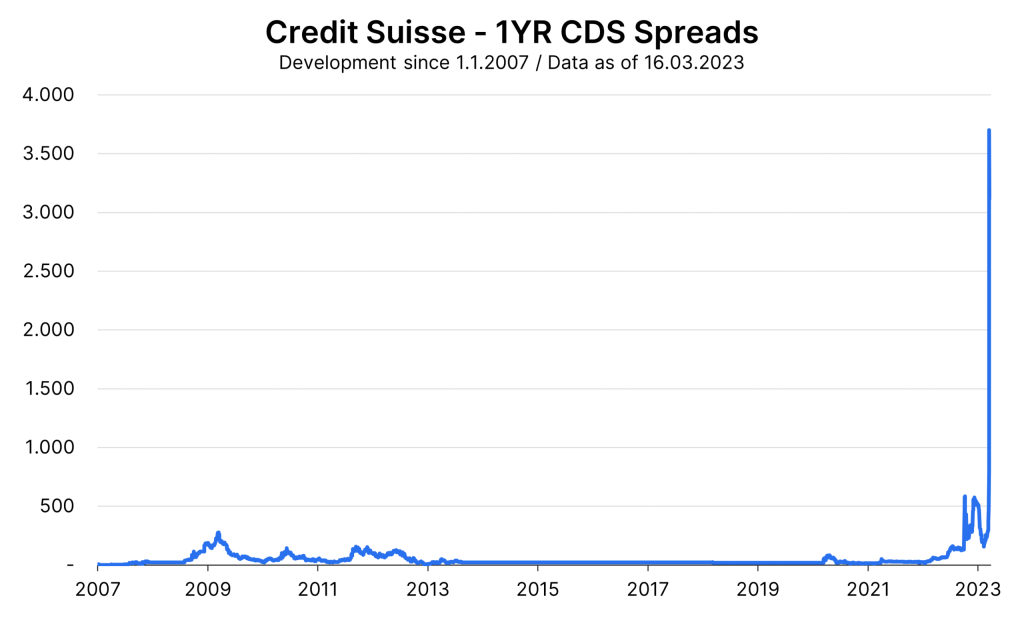Following the turbulence at several US regional banks, the major Swiss bank Credit Suisse (CS) also came under pressure in midweek. The bank had already been in the focus of market participants in recent months as it underwent a large-scale restructuring of its business model.
Uncertainty among investors
This week, the pressure increased significantly after Credit Suisse announced problems with previous years’ balance sheets and Saudi National Bank, a major shareholder of CS, made it clear that it would not make any further investments in the bank.
This caused uncertainty among investors, and the bank’s shares and bonds sold off sharply. The stock lost more than 24% during the day and credit default swaps, which are used to hedge against a bank default, traded at higher levels than during the great financial crisis of 2008.
The negative sentiment spilled over to the rest of the financial markets. The EuroStoxx 600 closed down 2.9% and safe havens (government bonds) were in strong demand. The yield on 10-year government bonds from the USA fell from 3.7% to 3.5% and that on German bonds from 2.4% to 2.1%.

Note: Past performance is not a reliable indicator for future performance.
What are CDS?
A credit default swap is a credit derivative entered into between two parties that enables trading in the default risks of bonds, loans or debtors. The protection buyer pays a premium (swap) to the protection seller and receives a compensation payment from the protection seller if the debtor is unable to settle its debt.
Swiss National Bank Grants Liquidity Assistance
In the evening of yesterday, Wednesday, the Swiss National Bank then announced that it would grant liquidity assistance to Credit Suisse. In doing so, the bank will
1) borrow up to 50 billion Swiss francs from the central bank and
2) buy back about SFr. 3 billion in debt,
in order to strengthen its liquidity position on the one hand and to reassure market participants on the other.
In early trading in Europe, these measures also had an effect. Futures contracts on European equity indices are noticeably up and the Credit Suisse share gained more than 20% at times.
How do we assess the current situation?
We continue to believe that the European and US banking systems are fundamentally sound. This is especially true for the global systemically important banks, which have been heavily regulated since the 2008 financial crisis to ensure that they have excess assets over liabilities even in economic stress scenarios (=bank failure).
Central banks in the US and Switzerland have also shown in recent days that they are stand by to support the liquidity situation of banks in the event of a crisis (=bank liquidity).
In principle, a central bank has three functions:
- Low inflation
- Financial market stability and
- Full employment.
In our view, at least in the short term, the hierarchy of priorities has shifted from 1) to 2). But even if financial market stability remains guaranteed, and the rapid intervention of central banks speaks in favor of this, a more restrictive credit environment could remain as a lasting effect. This would put pressure on economic growth.
For a glossary of technical terms, please visit this link: Fund Glossary | Erste Asset Management
Legal note:
Prognoses are no reliable indicator for future performance.
Legal disclaimer
This document is an advertisement. Unless indicated otherwise, source: Erste Asset Management GmbH. The language of communication of the sales offices is German and the languages of communication of the Management Company also include English.
The prospectus for UCITS funds (including any amendments) is prepared and published in accordance with the provisions of the InvFG 2011 as amended. Information for Investors pursuant to § 21 AIFMG is prepared for the alternative investment funds (AIF) administered by Erste Asset Management GmbH pursuant to the provisions of the AIFMG in conjunction with the InvFG 2011.
The currently valid versions of the prospectus, the Information for Investors pursuant to § 21 AIFMG, and the key information document can be found on the website www.erste-am.com under “Mandatory publications” and can be obtained free of charge by interested investors at the offices of the Management Company and at the offices of the depositary bank. The exact date of the most recent publication of the prospectus, the languages in which the key information document is available, and any other locations where the documents can be obtained are indicated on the website www.erste-am.com. A summary of the investor rights is available in German and English on the website www.erste-am.com/investor-rights and can also be obtained from the Management Company.
The Management Company can decide to suspend the provisions it has taken for the sale of unit certificates in other countries in accordance with the regulatory requirements.
Note: You are about to purchase a product that may be difficult to understand. We recommend that you read the indicated fund documents before making an investment decision. In addition to the locations listed above, you can obtain these documents free of charge at the offices of the referring Sparkassen bank and the offices of Erste Bank der oesterreichischen Sparkassen AG. You can also access these documents electronically at www.erste-am.com.
N.B.: The performance scenarios listed in the key information document are based on a calculation method that is specified in an EU regulation. The future market development cannot be accurately predicted. The depicted performance scenarios merely present potential earnings, but are based on the earnings in the recent past. The actual earnings may be lower than indicated. Our analyses and conclusions are general in nature and do not take into account the individual characteristics of our investors in terms of earnings, taxation, experience and knowledge, investment objective, financial position, capacity for loss, and risk tolerance.
Please note: Past performance is not a reliable indicator of the future performance of a fund. Investments in securities entail risks in addition to the opportunities presented here. The value of units and their earnings can rise and fall. Changes in exchange rates can also have a positive or negative effect on the value of an investment. For this reason, you may receive less than your originally invested amount when you redeem your units. Persons who are interested in purchasing units in investment funds are advised to read the current fund prospectus(es) and the Information for Investors pursuant to § 21 AIFMG, especially the risk notices they contain, before making an investment decision. If the fund currency is different than the investor’s home currency, changes in the relevant exchange rate can positively or negatively influence the value of the investment and the amount of the costs associated with the fund in the home currency.
We are not permitted to directly or indirectly offer, sell, transfer, or deliver this financial product to natural or legal persons whose place of residence or domicile is located in a country where this is legally prohibited. In this case, we may not provide any product information, either.
Please consult the corresponding information in the fund prospectus and the Information for Investors pursuant to § 21 AIFMG for restrictions on the sale of the fund to American or Russian citizens.
It is expressly noted that this communication does not provide any investment recommendations, but only expresses our current market assessment. Thus, this communication is not a substitute for investment advice, does not take into account the legal regulations aimed at promoting the independence of financial analyses, and is not subject to a prohibition on trading following the distribution of financial analyses.
This document does not represent a sales activity of the Management Company and therefore may not be construed as an offer for the purchase or sale of financial or investment instruments.
Erste Asset Management GmbH is affiliated with the referring Sparkassen banks and Erste Bank.
Please also read the “Information about us and our securities services” published by your bank.
Subject to misprints and errors.


